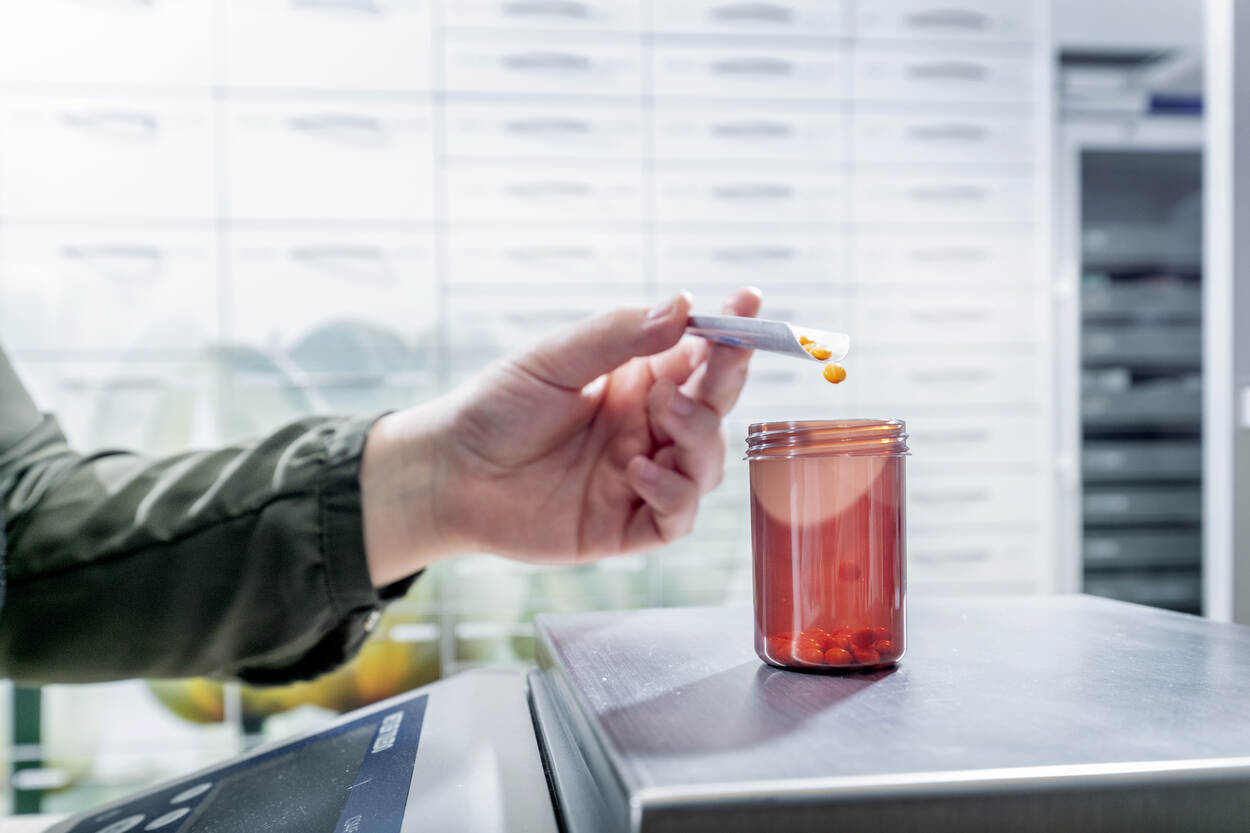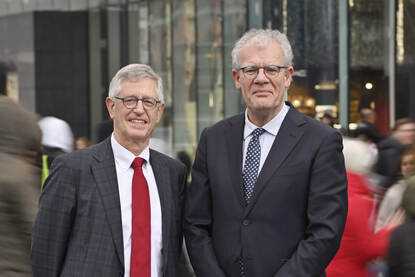In order to be allowed to introduce medicinal products for human use to the market, a pharmaceutical company requires a marketing authorisation. The various procedures that are available for obtaining a marketing authorisation for a medicinal product are discussed more specifically in the chapter ‘Procedures to introduce a medicinal product to the market’.
European committees
In the following two scientific committees of the European Medicines Agency (EMA), the member states join forces in the assessment of medicinal products for human use within the framework of the European centralised procedure: the Committee for Medicinal Products for Human Use (CHMP) and the Pharmacovigilance Risk Assessment Committee (PRAC). Representatives of all EU countries have a seat in these committees. The committees convene every month at the EMA in Amsterdam.
If the Netherlands is the rapporteur, the assessment of the dossier is carried out by a team of MEB colleagues. The composition of this team depends on the medicinal product and the questions that have to be answered in connection with the assessment of the product. The outcomes of the assessment are then put before the Board, after which the Board decides with which proposal the Dutch CHMP or PRAC members will enter the discussion in the relevant committees.
The EMA has criteria in place for assigning rapporteurships and co-rapporteurships to ensure that this takes place based on the best available expertise in the member states. There is also room here for countries that have not been rapporteurs that often in the past.
The assignment of co-rapporteurships at the PRAC is different from that of the CHMP: the country that is CHMP rapporteur, automatically becomes the PRAC co-rapporteur.
Besides the CHMP and the PRAC , there are three other scientific committees for medicinal products for human use in the centralised procedure and one comparable working group at the EMA: the Committee for Orphan Medicinal Products (COMP), the Paediatric Committee (PDCO), the Herbal Medicinal Products Committee (HMPC) and the Scientific Advice Working Party (SAWP).
The coordination of the European work in connection with the decentralised and mutual recognition procedures has been delegated to the Coordination Group for Mutual Recognition and Decentralised Procedures human (CMDh). The CMDh is a scientific committee of the member states but convenes, just as the other committees, at the EMA and is also supported by the EMA.
Rapporteurships and co-rapporteurships assigned via the centralised procedure (CHMP)
The CHMP is also responsible for assessing centralised applications for marketing authorisations of medicinal products.
Assigned (co-)rapporteurships
| Co-rapporteur | Rapporteur | |
|---|---|---|
| 2016 | 4 | 8 |
| 2017 | 6 | 7 |
| 2018 | 5 | 18 |
| 2019 | 11 | 24 |
Assigned (co-)rapporteurships
| Land | Aantal |
|---|---|
| Zweden | 21 |
| Nederland | 35 |
| Duitsland | 25 |
| Oostenrijk | 15 |
| Spanje | 19 |
| Denemarken | 19 |
| Frankrijk | 19 |
| Ierland | 18 |
| Polen | 16 |
| Finland | 9 |
| Tsjechië | 10 |
| Noorwegen | 7 |
| Portugal | 13 |
| Italië | 5 |
| Hongarije | 2 |
| Estland | 6 |
| IJsland | 2 |
| België | 11 |
| Letland | 4 |
| Malta | 8 |
| Kroatië | 4 |
| Roemenië | 3 |
| Griekenland | 1 |
| Litouwen | 3 |
| Slovenië | 3 |
| Slowakije | 3 |
| Verenigd Koninkrijk | 0 |
| Bulgarije | 0 |
| Cyprus | 0 |
| Luxemburg | 1 |
The number of rapporteurships and co-rapporteurships that were assigned to the MEB rose further in 2019. Due to Brexit, the United Kingdom was no longer assigned rapporteurships nor co-rapporteurships in 2019.
It is noteworthy that nearly all affiliated countries were assigned one or several rapporteurships or co-rapporteurships in 2019. The MEB considers this an important development, as this can eventually contribute to a strong and flexible European network.
More European cooperation
The MEB also plays an important role in multinational assessment teams, the MNATs. In these teams, a rapporteurship is carried out jointly by several countries so that countries with less experience in rapporteurships have the opportunity to gain experience.
Assigned PRAC pharmacovigilance rapporteurships
The Pharmacovigilance Risk Assessment Committee (PRAC) plays an important role in terms of supervising the risks of medicinal products for human use in Europe. The PRAC makes recommendations to the CHMP and the CMDh about the risks of medicinal products which are or will be authorised in the European Union.
Assigned pharmacovigilance rapporteurships
| Land | Aantal |
|---|---|
| Zweden | 16 |
| Nederland | 31 |
| Duitsland | 21 |
| Frankrijk | 7 |
| Spanje | 5 |
| Denemarken | 8 |
| Oostenrijk | 10 |
| Finland | 7 |
| Ierland | 2 |
| Polen | 8 |
| België | 6 |
| Italië | 10 |
| Noorwegen | 0 |
| Verenigd Koninkrijk | 0 |
| Hongarije | 1 |
| Letland | 1 |
| Litouwen | 0 |
| Portugal | 4 |
| Tsjechië | 5 |
| Kroatië | 3 |
| Slowakije | 2 |
| Bulgarije | 0 |
| Cyprus | 0 |
| Estland | 0 |
| Griekenland | 0 |
| IJsland | 0 |
| Luxemburg | 0 |
| Malta | 0 |
| Roemenië | 0 |
| Slovenië | 0 |
Assigned pharmacovigilance rapporteurships
| Other | New substances | |
|---|---|---|
| 2016 | 9 | 10 |
| 2017 | 0 | 14 |
| 2018 | 5 | 11 |
| 2019 | 12 | 19 |
In 2019, there were 30% more PRAC rapporteurships in Europe than in the previous year. This partially explains the increase in the number of rapporteurships for the Netherlands. Of the 31 PRAC rapporteurships that were assigned to the MEB, 19 were for new active substances. The other rapporteurships concerned other generics and biosimilars. With this number of PRAC rapporteurships, the Netherlands plays a leading role within Europe.
As in 2018, it is notable that nearly one third of the European network does not participate in PRAC rapporteurships and that the United Kingdom no longer participated in 2019 due to Brexit. Furthermore, the Netherlands is responsible for the pharmacovigilance of 89 active substances within Europe, just like previous year, the Netherlands is responsible for the pharmacovigilance of 89 active substances. This means that for these 89 substances, the Netherlands is responsible for analysing data in the European database of suspected adverse reactions, the EudraVigilance database, and identifying signs of possible new or changing risks.
Initialised applications via the decentralised procedure and mutual recognition procedure
The Netherlands also initialised many procedures as reference member state (RMS) in 2019. The number of procedures for which the MEB does this has remained at a constantly high level in recent years. The MEB gives pharmaceutical companies the possibility to reserve timeslots in which the application is reviewed. This enables the reference member state to regulate the number of applications. It is noteworthy that, within Europe, the Netherlands and Germany, with 235 and 229 initialised DCP applications respectively, together coordinate nearly 44% of all DCP procedures within Europe.
Initialised RMS-applications via the decentralised procedure (DCP) and mutual recognition procedure (MRP)
| MRP | DCP | |
|---|---|---|
| 2016 | 61 | 243 |
| 2017 | 70 | 230 |
| 2018 | 57 | 211 |
| 2019 | 60 | 235 |
Initialised RMS-applications via the decentralised procedure and mutual recognition procedure
| Land | DCP en MRP |
|---|---|
| Oostenrijk | 74 |
| België | 5 |
| Bulgarije | 0 |
| Kroatië | 15 |
| Cyprus | 0 |
| Tsjechië | 37 |
| Denemarken | 106 |
| Estland | 9 |
| Finland | 22 |
| Frankrijk | 7 |
| Duitsland | 269 |
| Griekenland | 1 |
| Hongarije | 21 |
| Ijsland | 32 |
| Ierland | 22 |
| Italië | 8 |
| Letland | 17 |
| Litouwen | 1 |
| Malta | 40 |
| Nederland | 295 |
| Noorwegen | 13 |
| Polen | 10 |
| Portugal | 136 |
| Roemenië | 1 |
| Slowakije | 7 |
| Slovenië | 4 |
| Spanje | 50 |
| Zweden | 97 |
| Verenigd Koninkrijk | 81 |
Applications via the national procedure
The number of submitted national applications (with the exception of parallel import, including duplex procedures, see below) fluctuates over the years, with a slight increase in 2019 compared to 2018. In the majority of cases, applicants prefer a European procedure (centralised and DCP) so that the product can be introduced to the market in several European countries.
Applications via the national procedure
| 2016 | 2017 | 2018 | 2019 | |
|---|---|---|---|---|
| Number of applications via the national procedure | 46 | 66 | 57 | 67 |
National parallel import applications
After an increase in submitted parallel import application in recent years, 2019 showed a rather sharp decrease compared to this trend. It is difficult to provide an explanation for this, however the coming into force of the Falsified Medicines Directive (FMD) might play a role. After all, it is more difficult to satisfy the requirements for safety features in the case of parallel import, also because the package must also contain a package leaflet in Dutch.
National parallel import applications
| 2016 | 2017 | 2018 | 2019 | |
|---|---|---|---|---|
| National parallel import applications | 428 | 445 | 521 | 375 |
Number of authorised marketing authorisations
After a small increase in the past years, the number of marketing authorisations in the Netherlands in 2019 remained nearly the same compared to 2018. This is due to two developments that offset each other. On the one hand, the number of newly authorised marketing authorisations rose. On the other hand, the number of withdrawn products in 2019 was higher than in previous years. It is difficult to provide one clear explanation for this; the coming into effect of the FMD coming into effect and Brexit could possibly play a role in this.
Number of authorised marketing authorisations
| 2016 | 2017 | 2018 | 2019 | |
|---|---|---|---|---|
| Number of authorised marketing authorisations | 14004 | 14078 | 14236 | 14239 |
Withdrawals
If a pharmaceutical company submits a request for a withdrawal, it is examined whether this concerns a critical product; for example whether there are no comparable medicinal products in the same medicinal product group. If this is the case, the MEB will explore which other possibilities there are to retain the product for the Dutch market. The MEB will do this in consultation with the marketing authorisation holder.
Withdrawals
| 2016 | 2017 | 2018 | 2019 | |
|---|---|---|---|---|
| Number of withdrawals | 1052 | 1232 | 1208 | 1385 |
Scientific advice
By providing scientific advice, the MEB can contribute to the responsible development of medicinal products, to innovation and early patient access. Scientific advice can concern all aspects of the product development, such as clinical or toxicological aspects, but also regulatory aspects. Providing national scientific advice is a statutory task that falls under the direct responsibility of the Board. Centralised scientific advice is prepared by the SAWP and falls under the responsibility of the CHMP. In the event of centralised European scientific advice, the answers to the questions asked will concern a European consensus. The MEB is active in both types of scientific advice (European and national).
Number of assigned scientific advice requests in Europe
The MEB was involved in more European scientific advice requests in 2019 than in previous years. The distribution over the European network which was started a year earlier, is continued: all countries (with the exception of the United Kingdom) played a role in 2019 in one or several scientific advice requests, whereas only six countries were active in this area in 2017.
Assigned scientific advice requests in Europe via SAWP
| 2016 | 2017 | 2018 | 2019 | |
|---|---|---|---|---|
| Assigned scientific advice requests in Europe via SAWP | 106 | 135 | 130 | 142 |
Assigned scientific advice requests in Europe via SAWP
| Land | 2019 |
|---|---|
| Oostenrijk | 164 |
| Duitsland | 185 |
| Denemarken | 59 |
| Verenigd Koninkrijk | 0 |
| Nederland | 142 |
| België | 144 |
| Zweden | 85 |
| Italië | 46 |
| Soanje | 46 |
| Frankrijk | 86 |
| Finland | 78 |
| Ierland | 97 |
| Portugal | 50 |
| Ijsland | 69 |
| Noorwegen | 43 |
| Kroatië | 25 |
| Polen | 36 |
| Litouwen | 21 |
| Malta | 19 |
| Letland | 1 |
| Slowakije | 3 |
Number of national scientific advice requests
The number of national scientific advice requests has increased gradually in recent years. This increase continued in 2019.
The MEB also provides customised advice, in which start-ups, small companies and scientific university groups are offered the possibility to request advice at a reduced rate. This form of scientific advice was further expanded in 2019. Providing this type of advice stimulates innovation at universities and small companies. The MEB was also actively involved in 2019, as in 2018, in the drug-rediscovery projects of ZonMw (the Dutch institute that stimulates and finances healthcare research and innovation).
The MEB performed a regulatory test thirteen times in 2019 for drug-rediscovery applications to ZonMw. With these assessments of project applications for research into medicinal products, which are sometimes already used off-label, the MEB contributes to possible on-label use by registering the use in question. This provides important advantages for prescribers and patients (the authorised use forms part of the product information, including the package leaflet) and for the pharmacovigilance.
In addition, various initiatives that were started earlier were continued in 2019, such as providing joint scientific advice with the National Healthcare Institute (ZIN) and the Central Committee for Research Involving Human Subjects (CCMO).
National scientific advice requests
| Scientific advice | Customised scientific advice | |
|---|---|---|
| 2016 | 78 | 12 |
| 2017 | 101 | 12 |
| 2018 | 110 | 6 |
| 2019 | 115 | 14 |
Number of concluded cases (including variations)
The MEB handles hundreds of cases every week; from marketing authorisation applications and applications for indication extensions to smaller variations, such as changing a manufacturer in the dossier, adding an adverse reaction or changing the shelf life of a medicinal product.
The number of cases concluded by the MEB continues to grow each year. Compared to 2016, the MEB concluded 60% more cases in 2019; the increase compared to 2018 was also considerable. An important reason for this increase is the large increase in the number of cases regarding shortages. These cases concern the handling of notifications received regarding shortages or defects of medicinal products. Brexit also resulted in a larger number of cases in 2019 concerning variations in medicinal product dossiers.
Number of concluded cases
| 2016 | 2017 | 2018 | 2019 | |
|---|---|---|---|---|
| Number of concluded cases, including variations | 18060 | 19666 | 25071 | 28959 |
Adverse reactions
Signalling and assessing adverse reactions of a medicinal product, also when the product has already been authorised, is one of the MEB's core tasks. At the MEB's request, the Netherlands Pharmacovigilance Centre Lareb collects, registers and analyses reports of suspected adverse reactions from medical professionals and patients. Lareb discusses relevant findings from these analyses with the MEB.
Lareb and the MEB discussed 65 analyses of reports of suspected adverse reactions in 2019, of which 16 were elaborated for discussion in the Board meetings and two in the Medical Practice Committee of the MEB. The other analyses were also followed up through the processing of the information by the MEB itself in an existing procedure and through the continuous monitoring of the reports. A further follow-up was not necessary in a number of cases, as the information had already been sufficiently processed.
Lareb reports
| Discussed by Board | Medical Practice Committee | Other | |
|---|---|---|---|
| 2018 | 11 | 3 | 36 |
| 2019 | 16 | 2 | 47 |
Direct Healthcare Professional Communication
In the event of urgent and/or important safety issues, healthcare professionals are informed by means of a letter, referred to as Direct Healthcare Professional Communication (DHPC). This took place 29 times in 2019.
Direct Healthcare Professional Communications
| 2016 | 2017 | 2018 | 2019 | |
|---|---|---|---|---|
| Number of DHPC's | 30 | 21 | 31 | 29 |
Shortages
The Medicine shortages and defects notification centre received 3,070 notifications of expected supply disruptions in 2019. This was over twice as many as in 2018. These 3,070 notifications concerned more than 1,965 different medicinal products. Therefore, one third of the notifications concerned a medicinal product about which a notification had already been received earlier. This is due to the fact that pharmaceutical companies sometimes foresee a supply disruption for the same medicinal product several times or because a supply disruption takes longer than originally indicated in the first notification.
Production problems and problems with the release of the final product, amounting to 58% together, are the most important reasons for the notifications. An increase in demand for a medicinal product (21%) was also often cited as a reason. Business economic reasons were given the least as a cause for the notifications (1%). A small share of the supply problems (8%) was caused by recalls, due to impurities involving nitrosamines, such as in the case of the antacid ranitidine.







